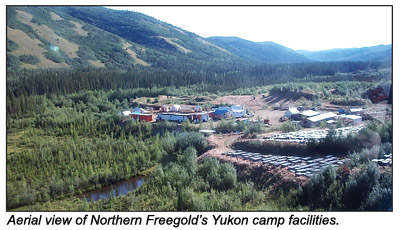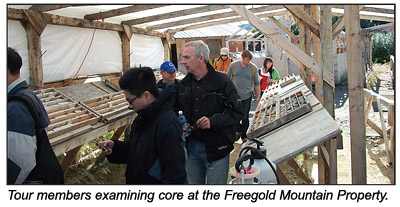Large Scale Mining
Free / Large Scale Mining
Freegold Mountain Project
September 2012 by Leonard
Few areas of the world have a mining history comparable to Canada’s Yukon Territory thanks to the fabled Klondike Gold Rush, which took place from the late 1890s into the early years of the Twentieth Century. Tens of thousands of prospectors and treasure hunters poured into the Territory following the discovery of placer gold along a tributary of the Klondike River, itself a tributary of the mighty Yukon River.
One company active in seeking new mineral wealth in this fascinating and beautiful region is Vancouver-based Northern Freegold Resources Ltd. During late July, in association with the Yukon Gold Mining Alliance, the company hosted a touring group of journalists, industry analysts and geologists at their Freegold Mountain Project located about 125 miles (200 km) northwest of the capital city of Whitehorse. Your columnist was fortunate to be a part of that tour.
Several factors have combined to raise the importance of mining to the general economy of the Yukon, thereby motivating both the Canadian federal government in Ottawa and Yukon’s Territorial government in Whitehorse  to favor the mining industry. As a result, the Yukon consistently ranks in the top ten in the well-known Fraser Institute mining-related ratings of government jurisdictions around the world.
to favor the mining industry. As a result, the Yukon consistently ranks in the top ten in the well-known Fraser Institute mining-related ratings of government jurisdictions around the world.
One specific reason for enhanced government assistance to the industry is that there are few economic alternatives within the Yukon. The bitterly cold and lengthy winters preclude almost all commercial agriculture; the short growing season combined with rugged terrain sharply limits any potential for forestry; the distance of most of the Yukon from ocean waters virtually eliminates the potential for large-scale commercial fisheries; and the combination of brutal winters and rugged terrain takes cattle ranching out of the commercial economic picture.
As a result, both levels of government recognize the reality that mining offers one of the only opportunities to advance the Yukon economy—and it doesn’t hurt that support for mining enterprises is an integral part of the culture of the Yukon.
For those who are history buffs, the world-famous Klondike Gold Rush that transformed the Yukon began in 1896 with the discovery of visible placer gold on Rabbit Creek, later renamed “Bonanza Creek.” As word of the gold find spread, an enormous, legendary rush into the Yukon took place with most “immigrants” gathering in Seattle, sailing to Skagway, Alaska, and then climbing the difficult—sometimes terrifying—White Pass, leading to the waters of the Yukon River and the interior of the Yukon. As the Yukon’s population and fame grew, the federal government granted the area Territorial status in 1898.
Within a short time, more than 100,000 prospectors and “wanna-be” merchants and entrepreneurs had poured into the Yukon, and the population of Dawson City—the central community of the Klondike Gold Rush—had swelled from a scattered few to almost 30,000 people.
Placer mining exploration and operations soon spread into many areas of the Yukon, leaving behind a body of knowledge that has proven invaluable to this era’s mining explorers and developers, based on the concept that if gold—one of nature’s heaviest elements—had found its way down to the bottom of river valleys, it most likely originated somewhere in the heights above.
The Freegold Mountain Project is located within an active exploration area in the Tintina Gold Belt, which stretches across parts of the Yukon and Alaska. Both the producing Fort Knox Mine, operated by Kinross Gold and the Pogo Mine, operated by Sumitomo Metal Mining are located in Alaska while more recent discoveries  including Kaminak Gold Corporation and Atac Resources are in the Yukon. Both jurisdictions host numerous multi-million-ounce gold deposits.
including Kaminak Gold Corporation and Atac Resources are in the Yukon. Both jurisdictions host numerous multi-million-ounce gold deposits.
Northern Freegold has published two recent Resource Estimates for the Freegold Mountain Project. The April 2011 Resource Estimates showed an Indicated Resource at the Nucleus Deposit of 1.1 million ounces of gold (Au), 1.4 million ounces silver (Ag), and 67.8 million pounds of copper (Cu) or 1.4 million ounces gold equivalent (AuEq) within 48.5 million tonnes grading 0.70 g/t Au, 0.90 g/t Ag and 0.06 Cu at a cut-off grade of 0.4 g/t AuEq, plus an Inferred Resource of 600,000 oz. Au and 62.0 million lbs. of Cu or 0.9 g/t AuEq within 41.5 million tonnes grading 0.47 g/t Au, 0.98 g/t Ag and 0.07% Cu.
In addition, an April 2012 Resource Estimate showed a 3.6 million ounce AuEq Inferred resource at the Revenue Deposit consisting of 1.1 million oz. Au, 10.2 million oz. Ag, 287 million lbs. Cu and 90 million lbs. molybdenum.
Freegold Mountain has a lengthy exploration history dating back to the initial discovery of lode gold in 1930 by prospector P. F. Guder. As word of Guder’s discovery spread, a mini gold rush developed with prospectors eventually staking over 100 claims. Following this initial burst of activity, only sporadic exploration work took place until the 1950s when the area was caught up in a new search for porphyry deposits.
Since the 1960s, the Freegold Mountain Property had been owned and explored by a patchwork of individuals and companies and finally, in 2006, all the various claims were consolidated by Northern Freegold Resources into one cohesive project area covering about 200 square kilometers within the Whitehorse Mining District. The company negotiated an agreement in 2006 to acquire a 50% interest in the project, and a later agreement was negotiated in 2007 allowing the company to acquire a 100% interest, subject to 1-3% Net Smelter Return (NSR) provision with previous owner ATAC Resources.
Freegold Mountain is underlain by Paleozoic or older metasedimentary and lesser metavolcanic rocks belonging to the Yukon-Tenana Terrane. The basement metamorphic rocks are extensively intruded by Jurassic to Late Cretaceous igneous rocks of the Coast Plutonic Complex. Mid-Cretaceous intrusive rocks include the Dawson Range Batholith, Casino granodiorite and Coffee Creek Granite.
The company has conducted extensive exploration work since 2006, including several diamond and reverse circulation drill programs; induced polarization (IP) surveys; geochemical surveys; geological mapping; stream geochemical sampling and ground geophysics. At various times, the company’s work camps have hosted as many as 70 employees.
NFR plans to have an updated Resource Estimate prepared by the end of fall 2012 and a preliminary economic assessment by early 2013. In order to work toward those goals, metallurgical testing was started in February 2012, and 2,500 meters of drilling, excavator trenching and environmental baseline studies were started during June 2012.
The company has a distinct advantage over many other exploratory deposits in the Yukon Territory in the form of infrastructure, which includes existing roads into Freegold Mountain as well as commercial power access just 30 km distant. According to company President and CEO John Burges, other companies without such  established road and available power sources can face infrastructure costs of many hundreds of millions of dollars before they can advance their projects toward eventual production.
established road and available power sources can face infrastructure costs of many hundreds of millions of dollars before they can advance their projects toward eventual production.
Burges also noted the company’s long-range goals include proving up a world class deposit as both the Nucleus and Revenue Deposits remain open in all directions and at depth with the polymetallic Tinta Deposit also available for exploration and development.
Eventual plans call for production from an open pit mine with concentrate shipments by river or road to deep water facilities located at Skagway. It is also worth noting that the Yukon government is considering plans to rehabilitate the old Yukon and White Pass Railway through to Whitehorse, which would provide a more reliable and potentially less expensive means for transporting material to and from Freegold Mountain.
At present, the Yukon is served by an international airport located in Whitehorse, plus several smaller facilities in communities like Dawson, as well as numerous private landing strips throughout the territory, many of them closely associated with mining activities. Helicopter service is also available for quick and reliable access to mining camps.
Aside from all the other advantages noted earlier, mining within the Yukon is also attractive for two other reasons. First, Canada and the Yukon provide a very stable background of government laws and regulations, unlike many nations in Africa, South America, Central America and elsewhere where courts are unreliable, taxation can be oppressive and governments often demand a portion of a company’s project before work can begin.
Second, relations between First Nations peoples and the Yukon government have been stable and agreements have been honored. During our tour, company Director Tim Termuende, P.G., also pointed out that the First Nations people in the Yukon tend to have lengthy periods of residence which means that as native personnel are trained, they are highly likely to be available for a lengthy period of time, thereby reducing or even eliminating frequent re-training, one of the difficulties faced by miners in other jurisdictions.
It is also worth noting that due to its remote location, difficulties presented by environmental regulatory procedures have tended to be much more reasonable and, as a result, the permitting process in the Yukon has tended to be more reliable than in other locales.
Further information is available online at www.northernfreegold.com or via email at administration@northernfreegold.com

© ICMJ's Prospecting and Mining Journal, CMJ Inc.